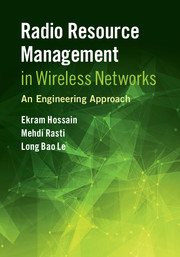Book contents
- Frontmatter
- Contents
- Preface
- Part I Basics of Wireless Networks
- Part II Techniques for Modeling and Analysis of Radio Resource Allocation Methods in Wireless Networks
- Part III Physical Layer Resource Allocation in Wireless Networks
- 5 General System Model and Preliminary Concepts
- 6 Power Control in Cellular Wireless Networks
- 7 Distributed Joint Power and Admission Control
- 8 Joint Power and Admission Control in Cognitive Radio Networks
- 9 Cell Association in Cellular Networks
- Part IV Link Layer Resource Allocation in Wireless Networks
- Part V Cross-Layer Modeling for Resource Allocation in Wireless Networks
- Index
- References
5 - General System Model and Preliminary Concepts
from Part III - Physical Layer Resource Allocation in Wireless Networks
Published online by Cambridge University Press: 11 May 2017
- Frontmatter
- Contents
- Preface
- Part I Basics of Wireless Networks
- Part II Techniques for Modeling and Analysis of Radio Resource Allocation Methods in Wireless Networks
- Part III Physical Layer Resource Allocation in Wireless Networks
- 5 General System Model and Preliminary Concepts
- 6 Power Control in Cellular Wireless Networks
- 7 Distributed Joint Power and Admission Control
- 8 Joint Power and Admission Control in Cognitive Radio Networks
- 9 Cell Association in Cellular Networks
- Part IV Link Layer Resource Allocation in Wireless Networks
- Part V Cross-Layer Modeling for Resource Allocation in Wireless Networks
- Index
- References
- Type
- Chapter
- Information
- Radio Resource Management in Wireless NetworksAn Engineering Approach, pp. 191 - 206Publisher: Cambridge University PressPrint publication year: 2017



